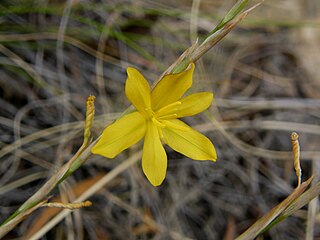
Iridaceae is a family of plants in order Asparagales, taking its name from the irises, meaning rainbow, referring to its many colours. There are 66 accepted genera with a total of c. 2244 species worldwide. It includes a number of other well known cultivated plants, such as freesias, gladioli and crocuses.

Dietes is a genus of rhizomatous plants of the family Iridaceae, first described as a genus in 1866. Common names include wood iris, fortnight lily, African iris, Japanese iris and butterfly iris, each of which may be used differently in different regions for one or more of the six species within the genus.
The vuvuzela is a horn, about 65 centimetres (2 ft) long, which produces a loud monotone note, typically around B♭ 3. Some models are made in two parts to facilitate storage, and this design also allows pitch variation. Many types of vuvuzela, made by several manufacturers, may produce various intensity and frequency outputs. The intensity of these outputs depends on the blowing technique and pressure exerted.

Moraea, the Cape tulips, is a genus of plants in the family Iridaceae, first described as a genus in 1758. The group is widespread across Africa, the Mediterranean, and central and southwestern Asia. The genus name is a tribute to the English botanist Robert More.

Moraea bellendenii is a species of plant in genus Moraea that was named after John Bellenden, the English botanist.

Moraea bituminosa is a species of the genus Moraea in family Iridaceae.

Moraea collina is a species of the genus Moraea, in the family Iridaceae. It was formerly known as Homeria collina.

Moraea aristata is a species of flowering plant in the family Iridaceae. It is referred to by the common names blue-eyed uintjie or Blouooguintjie in Afrikaans and is a critically endangered species of plant in the genus Moraea, that is endemic to the city of Cape Town and is now restricted to the grounds of the Observatory in the Cape Town suburb of Observatory.

Swartland Shale Renosterveld is a critically endangered vegetation type of the Western Cape, South Africa.

Diplarrena moraea, commonly known as white iris, is a member of the iris family, Iridaceae. It occurs in Australian heathland and forest in New South Wales, Victoria and Tasmania.

Moraea gawleri is a species of plant in the family Iridaceae. It is found in North Cape, South Africa.

Moraea macronyx is a species of plant in the family Iridaceae. It is found in Western Cape, South Africa.

Moraea gigandra is a species of plant in the family Iridaceae. It is found in South Africa.

Moraea fugacissima is a plant species in the family Iridaceae.

Moraea ochroleuca is a plant species in the family Iridaceae.

Moraea spathulata is a plant species in the family Iridaceae.

Moraea virgata is a plant species in the family Iridaceae.

Moraea sisyrinchium, the Barbary nut, is a species of flowering plant, a dwarf iris, in the genus Moraea, native to southern Europe and the Mediterranean region.

Moraea filicaulis is a flowering plant in the iris family, Iridaceae. It is endemic to South Africa where it occurs in Namaqualand, Knersvlakte, Olifants River Valley, and the West Coast. Moraea filicaulis is considered a species of least concern as it is widespread and common. It has previously been considered a subspecies of Moraea fugax.

















